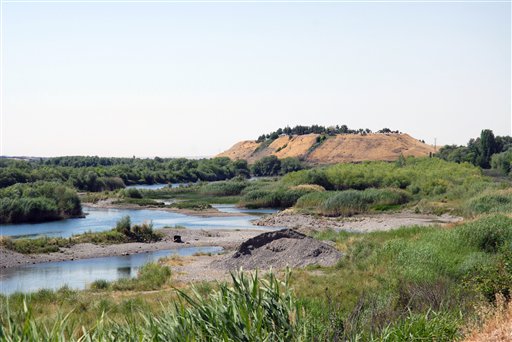(Turkey)
Ancient mounds are found around the world. Similar construction. Their purpose is sometimes burial and other times for some sort of supposed sacrifice or storage, living quarters or the like.
Tumulus: A tumulus (plural tumuli) is a mound of earth and stones raised over a grave or graves. Tumuli are also known as barrows, burial mounds, Hügelgräber or kurgans, and can be found throughout much of the world. A cairn (a mound of stones built for various purposes), might also be originally a tumulus. A long barrow is a long tumulus, usually for numbers of burials. The method of inhumation may involve a dolmen, a cist, a mortuary enclosure, a mortuary house or a chamber tomb.
Mounds: In the archaeology of the United States and Canada, the term "mound" has specific and technical connotations. In this sense, a mound is a deliberately constructed elevated earthen structure or earthwork, intended for a range of potential uses. In European and Asian archaeology, the word "tumulus" may be used as a synonym for an artificial hill, particularly if the hill is related to particular burial customs.
While the term "mound" may be applied to historic constructions, most mounds in the United States are pre-Columbian earthworks, built by Native American peoples. Native Americans built a variety of mounds, including flat-topped pyramids or cones known as platform mounds, rounded cones, and ridge or loaf-shaped mounds. Some mounds took on unusual shapes, such as the outline of cosmologically significant animals. These are known as effigy mounds. Some mounds, such as a few in Wisconsin, have rock formations, or petroforms within them, on them, or near them. (***Wisconsin is signficant as local tribes ancestors reported that they were not the ones mining copper there, but the "white men" who were there first*** See my post on copper mining giants)
How do you suppose man around the world was designing the same structures over and over again and again before their cross-ocean seafaring days, hmm??
(Mystery Mound, England)
Cahokia (Illinois)
(Bahrain, 4000-year-old burial mounds) In fact, these mounds were found on an island with people who lived off the sea - classic "originator" characteristic.
Above - This Russian mound skull from a 2500-year-old mound had a necklace they call the "Cleopatra Necklace" because it looked "Egyptian" (remember the finds in America believed to have Egyptian looking heiroglyphs and art? The signature of the "Originators" art and language seen around the world and influencing others?)
Does she kind of look like the Humboldt Sink "robust otamid" (Sloped-forehead skull) found in Oregon that I wrote about? *Notice the thrusting carnivorous robust jaw on the Russian mound skull and this Humboldt Sink one compared to the "homo sapiens" one below -
The interesting thing about all these mounds found around the world (besides the fact they were constructed nearly identically and shaped alike) is the very real fact that, if man was circumventing the globe and influencing each other's building in the BCE (before common era or what was known as Before Christ) era, they were not leaving their other cultural attributes. There should be Mesopotamian writings in Siberia and the Americas and pottery designs and such that are equivalent, as well as the skulls of those other culture people who do not belong there.
What we are left with is the possibility that such structures were being built around the world by a singular group that influenced incoming homo sapiens to imitate and initiate their own builds. The universal language of these "Originators" allowed similarities in early cuneiform writing around the world simultaneously. In fact, in Africa, they found that Heidelbergensis and Neanderthal, who came before homo sapiens in the continent, left tools behind that the homo sapiens borrowed and used. Those two originators also left the continent of Africa about 700,000 years before homo sapiens emerged from Africa to explore the world. What did they do for those 700,000 years??? How about build more knowledge and world exploration that we would cobble onto at a later date? In other words, they did all the hard early learning for us in the evolutionary process.
Source: It is generally agreed that true writing of language (not only numbers) was invented independently in at least two places: Mesopotamia (3200 BCE) and Mesoamerica around 600 BCE... It is debated whether writing systems were developed completely independently in Egypt around 3200 BCE and China around 1200 BCE or whether the appearance of writing in either or both places was due to culture diffusion.... brought by traders or an already-literate civilization!!!! (DING! DING! DING!)
What we are left with is a universal glue that holds all cultures together even when homo sapiens were not circumventing the globe in ships thousands of years BC. What was the giver of the Bronze age and the launcher of our great and fast knowledge? The influences we had since 80,000 years ago when leaving Africa - those who were the Originators.
These mounds are still a mystery as to how they were formed, though it is believed to have been an act of nature.













Comments
Post a Comment